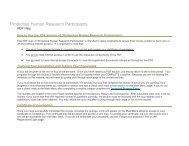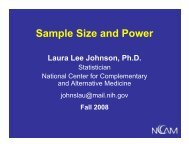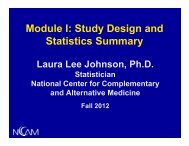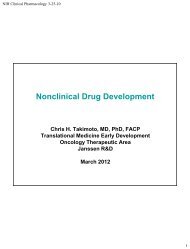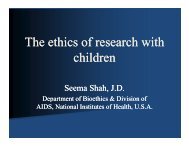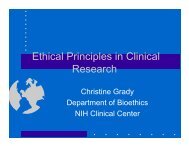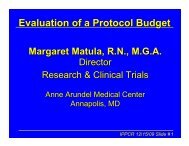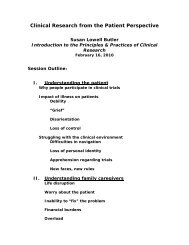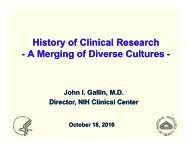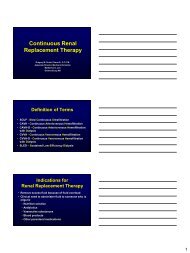Pathways of drug metabolism_3slides
Pathways of drug metabolism_3slides
Pathways of drug metabolism_3slides
Create successful ePaper yourself
Turn your PDF publications into a flip-book with our unique Google optimized e-Paper software.
Drug MetabolismS.P. MarkeyLaboratory <strong>of</strong> NeurotoxicologyNIMH, NIHDec. 2, 20101Metabolism vs Drug ActionR 1DrugTransportR 1Drug receptorR 2R 1Cytochromes P450(Oxidation)OHR 2R 2R 1R 2Inactive <strong>drug</strong>Transferases(Conjugation)O-SGTransportBiological responseExcretion throughkidney or bile2Drug MetabolismExtrahepatic microsomal enzymes(oxidation, conjugation)Hepatic microsomal enzymes(oxidation, conjugation)Hepatic non-microsomal enzymes(acetylation, sulfation,GSH,alcohol/aldehyde dehydrogenase,hydrolysis, ox/red)31
Liver Microsomal System•Oxidative Reactions: Cytochrome P450 mediated– Formation <strong>of</strong> an inactive polar metabolite• Phenobarbital4Liver Microsomal System•Oxidative Reactions: Cytochrome P450 mediated– Formation <strong>of</strong> a toxic metabolite• Acetaminophen – NAPQIHN COCH 3COCHN3Toxic EventsOHO5Liver Microsomal System•Oxidative Reactions: Cytochrome P450 mediated– Formation <strong>of</strong> an active metabolite• By Design: Purine & pyrimidine chemotherapy• Inadvertent: terfenadine – fex<strong>of</strong>enadine62
Evolution <strong>of</strong> Drug Metabolism As aSciencePost WWII Pioneers• Richard Tecwyn Williams – Great Britain– 1942, worked on the <strong>metabolism</strong> on TNT with regard to toxicityin munitions workers; due to the war he assembled teams towork on <strong>metabolism</strong> <strong>of</strong> sulfonamides, benzene, aniline,acetanilide, phenacetin, and stilbesterol– Developed concept <strong>of</strong> Phase 1 & Phase 2 Reactions.• Biotransformation involves metabolic oxygenation,reduction, or hydrolysis; result in changes in biologicalactivity (increased or decreased)• Second phase, conjugation, in almost all cases resulted indetoxification.7Evolution <strong>of</strong> Drug Metabolism As aScience• Bernard B. Brodie, U.S.Post WWII Pioneers– NYU and Laboratory <strong>of</strong> Industrial Hygiene, NYC 1949 –Metabolic fate <strong>of</strong> acetanilide and phenacetin in man(with Julius Axelrod as pre-doc; later an NIMH Nobellaureate)– 1950s, NIH – pioneering studies on all aspects <strong>of</strong> <strong>drug</strong><strong>metabolism</strong>; esp. reserpine, serotonin;hexobarbitaltolerance– 1952 – R.T. Williams spent 6 months at NIH;subsequently many students went between both labs(Richard Adamson, James Gillette, and SidneyUdenfriend)– 1950s, Brodie lab developed thespectrophot<strong>of</strong>luorimeter (Robert Bowman)8Sites <strong>of</strong> <strong>drug</strong> <strong>metabolism</strong> –Cytochromes P450 (CYPs)Liver enrichedEndoplasmic reticulumCertain transferases alsolocalized to the ER93
NADP +NADPHCYPR-AsePCCYP Fe +3e - e - 2H + H 2 ODrugDrugDrugOHCOCYP-Fe +2DrugCOhuCYP Fe +2DrugO 2CYP Fe +3DrugOHO 2CYP Fe +2DrugElectron flow in microsomal <strong>drug</strong> oxidizing system10Cytochrome P450 Is<strong>of</strong>orms (CYPs) - An Overview• NADPH + H + + O 2 + Drug NADP + + H 2 O + Oxidized Drug• Carbon monoxide binds to the reduced Fe(II) heme andabsorbs at 450 nm (origin <strong>of</strong> enzyme family name)• CYP monooxygenase enzyme family is major catalyst <strong>of</strong><strong>drug</strong> and endogenous compound oxidations in liver,kidney, G.I. tract, skin, lungs• Oxidative reactions require the CYP heme protein, thereductase, NADPH, phosphatidylcholine and molecularoxygen• CYPs are in smooth endoplasmic reticulum in closeassociation with NADPH-CYP reductase in 10/1 ratio• The reductase serves as the electron source for theoxidative reaction cycle11CYP Families• Multiple CYP gene families have been identified inhumans, and the categories are based upon proteinsequence homology• Most <strong>of</strong> the <strong>drug</strong> metabolizing enzymes are in CYP 1, 2,& 3 families .• CYPs have molecular weights <strong>of</strong> 45-60 kDa.• Frequently, two or more enzymes can catalyze thesame type <strong>of</strong> oxidation, indicating redundant andbroad substrate specificity.• CYP3A4 is very common to the <strong>metabolism</strong> <strong>of</strong> many<strong>drug</strong>s; its presence in the GI tract is responsible forpoor oral availabilty <strong>of</strong> many <strong>drug</strong>s124
2EROLE OF CYP ENZYMES IN HEPATICDRUG METABOLISMRELATIVE HEPATIC CONTENTOF CYP ENZYMESCYP2D62%CYP2E17%% DRUGS METABOLIZEDBY CYP ENZYMESCYP 2C17%CYP 1A212%CYP 3A4-526%OTHER36%CYP 2C914%CYP 1A214%CYP 2C1911%CYP 3A4-533%CYP2D623%CYP2E15%A. Atkinson, 200513Human Liver Drug CYPsCYPenzymeLevel(%total)Extent <strong>of</strong>variability1A2 ~ 13 ~40-fold1B1
Drug Metabolism Studies• Determine the nature <strong>of</strong> metabolitesStable metabolites goodElectrophilesbadBind to cellular nucleophile - DNA, RNA and proteinCause cell death or transformation – cancer• Which P450s are involved in <strong>metabolism</strong> <strong>of</strong> the<strong>drug</strong> candidate?Several P450sgoodSingle P450badCYP2D6 - polymorphismCYP3A4 - <strong>drug</strong> interactionsF. Gonzalez, 200916Factors Influencing Activity and Level <strong>of</strong> CYP EnzymesNutritionSmoking1A1;1A2; 1B1, 2A6, 2B6,2C8,9,19; 2D6, 3A4,51A1;1A2, 2E1Alcohol2E1Drugs1A1,1A2; 2A6; 2B6; 2C;2D6; 3A3, 3A4,5Environment1A1,1A2; 2A6; 1B; 2E1;3A3, 3A4,5Genetic 1A; 2A6; 2C9,19; 2D6;Polymorphism 2E1Red indicates enzymes important in <strong>drug</strong> <strong>metabolism</strong>Adapted from: S. Rendic Drug Metab Rev 34: 83-448, 200217Non-nitrogenous Substances that Affect DrugMetabolism• Grapefruit juice - CYP 3A4 inhibitor; highlyvariable effects; fucocoumarins– Bailey, D.G. et al.; Br J Clin Pharmacol 1998,46:101-110– Bailey, D.G et al.; Am J Cardiovasc Drugs 2004,4:281-97.• St John’s wort, other herbal products– Tirona, R.G and Bailey, D.G. ; Br J ClinPharmacol. 2006,61: 677-81• Isosafrole, safrole– CYP1A1, CYP1A2 inhibitor; found in root beer,perfume186
Overheard Conversation• At a B&B breakfast table, after grapefruit juicewas served, someone remarked “A friendread the package insert with her prescriptionand the fine print warned against drinkinggrapefruit juice…is this true? Should it beavoided with all medications? How aboutgrapefruit itself? How about orange juice?”19Effect <strong>of</strong> Grapefruit Juice onFelodipine Plasma Concentration5mg tabletwith juicewithoutClClCH 3 O 2 CClHCO 2 CH 33A4CH 3 O 2 CClCO 2 CH 3CH 3 N CH 3HCH 3 N CH 3Review- D.G. Bailey, et al.; Br J Clin Pharmacol 1998, 46:101-11020Grapefruit Juice Facts• GJ or G, lime, or Sun Drop Citrus soda, SevilleOJ(not most OJ) elevates plasma peak <strong>drug</strong>concentration, not elimination t 1/2• GJ reduced metabolite/parent <strong>drug</strong> AUC ratio• GJ caused 62% reduction in small bowelenterocyte 3A4 and 3A5 protein; liver not asmarkedly affected (i.v. pharmacokineticsunchanged)• GJ effects last ~4 h, require new enzymesynthesis• Effect cumulative (up to 5x C max ) and highlyvariable among individuals depending upon 3A4small bowel basal levels217
First-Pass Metabolism after Oral Administration <strong>of</strong> a Drug, as Exemplified byFelodipine and Its Interaction with Grapefruit Juice22Wilkinson G. N Engl J Med 2005;352:2211-2221Limited Expression <strong>of</strong> Human DrugMetabolizing CYPs in Extrahepatic TissuesS. Rendic & F.J. DiCarlo, Drug Metab Rev 29:413-80, 1997 23CYP Biotransformations - Summary• Chemically diverse small molecules areconverted, generally to more polar compounds• Reactions include:– Aliphatic hydroxylation, aromatic hydroxylation– Dealkylation (N-,O-, S-)– N-oxidation, S-oxidation– Deamination– Dehalogenation• Examples - see Principles <strong>of</strong> ClinicalPharmacology, Chapter 11248
Non-CYP Drug Biotransformations• Oxidations• Hydrolyses• Conjugation (Phase 2 Rxs)– Major Conjugation Reactions• Glucuronidation (high capacity)• Sulfation (low capacity)• Acetylation (variable capacity)– Examples: Procainamide, Isoniazid– Other Conjugation Reactions: O-Methylation, S-Methylation, Amino Acid Conjugation (glycine,taurine, glutathione)– Many conjugation enzymes exhibit polymorphism25Non-CYP <strong>drug</strong> oxidations (1)• Monoamine Oxidase (MAO), Diamine Oxidase (DAO) - MAO(mitochondrial) oxidatively deaminates endogenoussubstrates including neurotransmitters (dopamine, serotonin,norepinephrine, epinephrine); <strong>drug</strong>s designed to inhibit MAOused to affect balance <strong>of</strong> CNS neurotransmitters (L-DOPA);MPTP converted to toxin MPP+ through MAO-B. DAOsubstrates include histamine and polyamines.• Alcohol & Aldehyde Dehydrogenase - non-specific enzymesfound in soluble fraction <strong>of</strong> liver; ethanol <strong>metabolism</strong>• Xanthine Oxidase - converts hypoxanthine to xanthine, andthen to uric acid. Drug substrates include theophylline, 6-mercaptopurine. Allopurinol is substrate and inhibitor <strong>of</strong>xanthine oxidase; delays <strong>metabolism</strong> <strong>of</strong> other substrates;effective for treatment <strong>of</strong> gout.26Non-CYP <strong>drug</strong> oxidations (2)• Flavin Monooxygenases– Family <strong>of</strong> enzymes that catalyze oxygenation <strong>of</strong> nitrogen,phosphorus, sulfur – particularly facile formation <strong>of</strong> N-oxides– Different FMO is<strong>of</strong>orms have been isolated from liver, lung(S.K. Krueger, et al. Drug Metab Rev 2002; 34:523-32)– Complete structures defined (Review: J. Cashman, 1995,Chem Res Toxicol 8:165-181; Pharmacogenomics 2002; 3:325-39)– Require molecular oxygen, NADPH, flavin adenosinedinucleotide (FAD)– Single point (loose) enzyme-substrate contact with reactivehydroperoxyflavin monoxoygenating agent– FMOs are heat labile and metal-free, unlike CYPs– Factors affecting FMOs (diet, <strong>drug</strong>s, sex) not as highly studiedas CYPs279
Hydrolysis – Ester or Amide•Procaine – ester, rapidly hydrolyzed•Procainamide - amide, more slowly hydrolyzed; valuable antiarrhythmic•N-acetylprocainamide (NAPA); metabolite with anti-arrhythmicactivity, 2.5 x longer elimination half-life (Atkinson et al., 1988,Angiology, 39, 655-67)28Conjugation ReactionsGlucuronidationCO 2 HOOHOHOOHHO OP O P O CH 2O OH O NONHO+ROHorR 3 NUGTCO 2 HO O ROHOHOHO-glucuronideUDP--D-glucuronic acidCO 2 H RO N + ROHROHOHN + -glucuronideLiver has several soluble UDP-Gluc-transferases 29HO 3NOOHO6N CH 3NNCH 3MorphineAmitriptylineCotinineGlucuronic acid conjugation tophenols, 3°-amines, aromatic amines3010
Conjugation ReactionsSulfationR OHNH 2+N NN NHHHOOHHOHOH OO P O S OHO OOR O S OHO(PAPS, 3’-phosphoadenosine-5’-phosphosulfate)Examples: ethanol, p-hydroxyacetanilide, 3-hydroxycoumarin31H 2 NNNH 2 NNNNONH 2HOOSONONHMinoxidilMinoxidil-sulfateSulfation may produce active metabolite32Conjugation ReactionsAcetylationAr NH 2R NH 2+R OHR SHCoA SOAcetyl transferaseR OOAr NHCH 3HCH 3OR NR SOCH 3OCH 3Examples: Procainamide, isoniazid, sulfanilimide, histamineN-acetyl transferase (NAT) enzyme is found in many tissues,including liver3311
ProcainamideUnchangedin Urine, 59%H 2 NONHN24% Fast17% Slow3%Unchangedin Urine, 85%OHNNAPAONHN1%0.3%OHNONHHNH 2 NONHHN34ProcainamideH 2 NONHNtrace metaboliteHNHOONHNnon-enzymaticONONHNLupus?35Additional Effects on Drug Metabolism• Species Differences– Major differences in different species have beenrecognized for many years (R.T. Williams).• Phenylbutazone half-life is 3 h in rabbit, ~6 h in rat, guineapig, and dog and 3 days in humans.• Induction– Two major categories <strong>of</strong> CYP inducers• Phenobarbital is prototype <strong>of</strong> one group - enhances<strong>metabolism</strong> <strong>of</strong> wide variety <strong>of</strong> substrates by causingproliferation <strong>of</strong> SER and CYP in liver cells.• Polycylic aromatic hydrocarbons are second type <strong>of</strong>inducer (ex: benzo[a]pyrene).– Induction appears to be environmental adaptiveresponse <strong>of</strong> organism– Orphan Nuclear Receptors (PXR, CAR) areregulators <strong>of</strong> <strong>drug</strong> metabolizing gene expression3612
PXR and CAR Protect Against Xenobioticsco-activatorPBPCARtarget genesxenobioticsPXRRXRxenoprotectioncytoplasmnucleusS.A. Kliewer37Mechanism <strong>of</strong> Induction <strong>of</strong> CYP3A4-Mediated Metabolism <strong>of</strong> Drug Substrates (PanelA) and the Resulting Reduced Plasma Drug Concentration (Panel B)Wilkinson G. N Engl J Med 2005;352:2211-222138CYP3A Inducers ActivateHuman, Rabbit, and Rat PXRrifampicinPCNdexamethasoneRU486Cell-basedreporter assayclotrimazoletroglitazonetamoxifen1 3 5 7 9 11 13 15 17 19Reporter activity (fold)S.A. Kliewer3913
Pregnane X Receptor (PXR)human PXRrabbit PXRDNA94%Ligand82%mouse PXR 96% 77%rat PXR 96% 76%• PXR is one <strong>of</strong> Nuclear Receptor (NR) family <strong>of</strong> ligand-activatedtranscription factors.• Named on basis <strong>of</strong> activation by natural and synthetic C21 steroids(pregnanes), including pregnenolone 16-carbonitrile (PCN)• Cloned due to homology with other nuclear receptors• Highly active in liver and intestine• Binds as heterodimer with retinoic acid receptor (RXR)S.A. Kliewer40Constitutive Androstane Receptor (CAR)CARCARDNALigandPXRPXR 66% 41%S.A. Kliewer• Highly expressed in liver and intestine• Sequestered in cytoplasm• Co-factor complex required for activation;anchored by PPAR-binding protein (PBP)• Binds response elements as RXR heterodimer• High basal transcriptional activity without ligand• Activated by xenobiotics– phenobarbital, TCPOBOP (1,4-bis[2-(3,5-dichloropyridyloxy)]benzene)41Acetaminophen (APAP)Over-the-counter <strong>drug</strong>;relieving pain,reducing fever,relieving the symptoms <strong>of</strong>allergies, cold, cough, and flu.Co-administration:SedativeAntihistamineVasoconstrictantsExpectorantsAntitussiveAnalgesicsTylenol(Top seller, controlling 35% <strong>of</strong> the painkiller market in North America)C8H9NO2, MW 151.16Aspirin, C9H8O4, MW 180.164214
Acetaminophen (Paracetamol)• Acetanilide – 1886 – accidentally discoveredantipyretic; excessively toxic (methemoglobinemia);para-aminophenol and derivatives were tested.• Phenacetin introduced in 1887, and extensivelyused in analgesic mixtures until implicated inanalgesic abuse nephropathy• Acetaminophen recognized as metabolite in 1899• 1948-49 Brodie and Axelrod recognizedmethemoglobinemia due to acetanilide andanalgesia to acetaminophen• 1955 acetaminophen introduced in US43Acetaminophen and p-AminophenolsHN COCH 3HN COCH 3NH 2Acetanilide, 1886(accidental discovery <strong>of</strong>antipyretic activity; high toxicity)70-90%OC 2 H 575-80%OC 2 H 5Phenacetin oracetophenetidin, 1887(nephrotoxic,methemoglobinemia)NH 2HN COCH 3Metabolic pathway quantified;(Brodie &Axelrod, 1948)popular in US since 1955OHAcetaminophen, 189344Acetaminophen Toxicity•Acetaminophen overdose results in more calls topoison control centers in the United States thanoverdose with any other pharmacologic substance.•The American Liver Foundation reports that 35% <strong>of</strong>cases <strong>of</strong> severe liver failure are caused byacetaminophen poisoning which may require organtransplantation.•N-acetyl cysteine is an effective antidote, especially ifadministered within 10 h <strong>of</strong> ingestion [NEJM 319:1557-1562, 1988]•Management <strong>of</strong> acetaminophen overdose [TrendsPharm Sci 24:154-157, 20034515
Poisoning Fatalities U.S. 2006Categories associated with largest numbers <strong>of</strong> fatalitiesSubstanceNumberSedative/hypnotics/antipsychotics 382Opioids 307Cardiovascular Drugs 252Acetaminophen in combination 214Antidepressants 210Stimulants and street <strong>drug</strong>s 203Alcohols 139Acetaminophen only 138Excerpt from Table 18“2006 Annual Report <strong>of</strong> the American Association <strong>of</strong> Poison Control Centers' National Poison Data System”http://dx.doi.org/10.1080/1556365070175476346Acetominophen MetabolismHN COCH 3HN COCH 3OHOOOHCO 2 HOH~60% ~35%OHCYP2E1*CYP1A2CYP3A11NHN COCH 3O SO 3 H*induced by ethanol, isoniazidCOCH 347Protein adducts,OOxidative stressNAPQIToxicity N-acetyl-p-benzoquinone imineAcetaminophen Protein AdductsHN COCH 3COCHN3CYPsHS-ProteinOHOH 2 N-ProteinHN COCH 3HN COCH 3OOHS ProteinProtein48SCOCH 3 NNH ProteinOHS.D. Nelson, Drug Metab. Rev. 27: 147-177 (1995)K.D. Welch et al., Chem Res Toxicol 18:924-33 (2005)16
Acetaminophen toxicity mechanism• N-acetyl cysteine is an effective agent to block GSHdepletion and rescue from liver damaging toxicity• CAR and PXR modulate acetaminophen toxicity(2002, 2004)• CAR-null mice are resistant to acetaminophen toxicity– hepatic GSH lowered in wild type (but not in KO)after acetaminophen– CAR-humanized mice demonstrate same toxicityresponse• Activation <strong>of</strong> PXR induces CYP3A11 and markedlyenhances acetaminophen toxicity in wild type mice• CAR transcription co-activator KO blocks toxicity(2005)49NAPQI toxicity linked to PXR activationG. Guo et al. 2004, Toxicol Sci 82(2):374-80HN COCH 3CARPXROHXenobioticsCYP2E1*CYP3A11COCHN3toxicityOHN COCH 3GLYS CYSOHGLUSHglu-cys-glytoxicityoxidative stressmechanism ?50Differential effect <strong>of</strong> covalent protein modification and GSHdepletion on the transcriptional response <strong>of</strong> Nrf2 and NF-κBChia et al., Biochem Pharm. 80 (2010)410-4215117
Drug Metabolism - Web Information Resources•http://en.wikipedia.org/wiki/Cytochrome_P450_oxidase–General web site regarding all aspects <strong>of</strong> chemical structure(sequence and 3D) <strong>of</strong> P450 proteins from multiple species; linksto related sites including leading researchers on P450•http://www.fda.gov/cder/guidance/–Site contains many useful documents regarding <strong>drug</strong><strong>metabolism</strong> and FDA recommendations including "DrugMetabolism/Drug Interaction Studies in the Drug DevelopmentProcess: Studies in Vitro", FDA Guidance for Industry•http://www.sigmaaldrich.com/Area_<strong>of</strong>_Interest/Biochemicals/Enzyme_Explorer.html–Site has many commercially available <strong>drug</strong> metabolizingenzymes and useful links to multiple <strong>drug</strong> <strong>metabolism</strong> resources•http://elearn.pharmacy.ac.uk/flash/view/Cytochrome_P450.html–Animation <strong>of</strong> mechanism <strong>of</strong> Cytochrome P4505218



